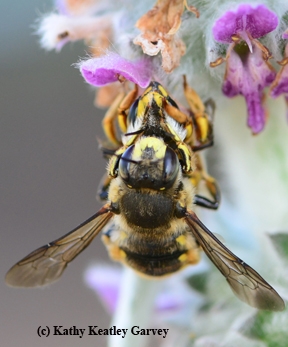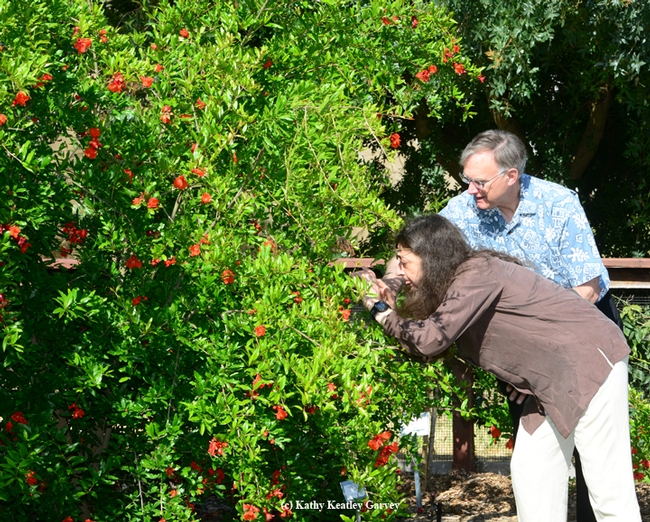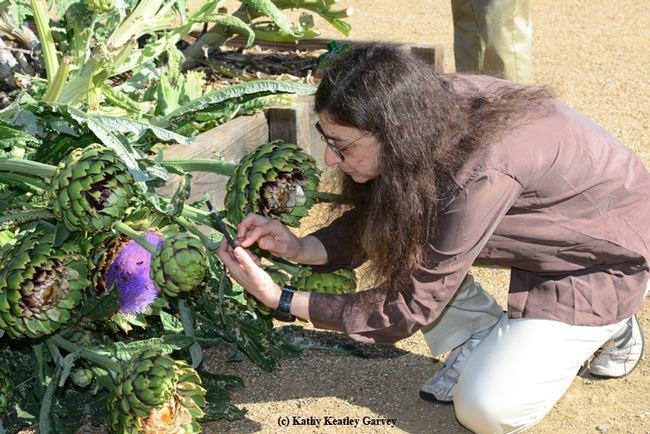
Visiting entomologist May Berenbaum, professor and head of the Department of Entomology at the University of Illinois at Urbana-Champaign, this morning stopped by the haven, a half-acre bee friendly garden on Bee Biology Road, University of California, Davis, to see the bee activity.
Joining her were Extension apiculturist Eric Mussen; bee scientist Brian Johnson, assistant professor of entomology, and native pollinator specialist Robbin Thorp, emeritus professor of entomology, all of the UC Davis Department of Entomology and Nematology.
The garden, planted in the fall of 2009, is located next to the Harry H. Laidlaw Jr. Honey Bee Research Facility. It is open year around, from dawn to dusk and maintained by the UC Davis Department of Entomology and Nematology.
Berenbaum, who will become the fifth woman president of the 7000-member Entomological Society of America in 2016, saw honey bees foraging on pomegranate and flowering artichoke blossoms and other flowers. Thorp pointed out the Valley carpenter bees, mountain carpenter bees, European wool carder bees, yellow-faced bumble bees and black-tailed bumble bees.
Thorp, who monitors the garden for bees, has found some 85 different species of bees--"and counting"--over the last five years. He began forming baseline data a year before the garden was planted.
The key goals of the garden are to provide bees with a year-around food source, to raise public awareness about the plight of honey bees and to encourage visitors to plant bee-friendly gardens of their own. Häagen-Dazs, a premier ice cream brand, generously supports the garden.
The garden design is the work of a Sausalito team which won the international design competition using a series of interconnected gardens with such names as “Honeycomb Hideout,” "Orchard Alley,” "Growers' Circle," “Round Dance Circle” and “Waggle Dance Way." ??The team: landscape architects Donald Sibbett and Ann F. Baker, interpretative planner Jessica Brainard and exhibit designer Chika Kurotaki.
The art work in the garden is by the UC Davis Art/Science Fusion Program, co-founded and co-directed by entomologist/associate dean Diane Ullman and self-described "rock artist" Donna Billick. Billick also created the six-foot long worker bee sculpture that anchors the garden. The sculpture, which Billick cleverly named "Miss Bee Haven," is of mosaic ceramic.
Berenbaum visited the UC Davis campus May 20-21 to deliver two presentations as part of the Storer Lectureships: "Bees in Crisis: Colony Collapse, Honey Laundering and Other Problems Bee-Setting American Apiculture" on May 20 and "Sex and the Single Parsnip: Coping with Florivores and Pollinators in Two Hemispheres" on May 21. (Click on this link to watch a video of her talk, "Bees in Crisis.")
Berenbaum, a talented scientist, dedicated researcher, dynamic speaker, creative author, and an insect ambassador who wants people to overcome their fear of insects, focuses her research on the chemical interactions between herbivorous insects and their host plants, and the implications of these interactions on the organization of natural communities and the evolution of species.
As as a spokesperson for the scientific community on the honey bee colony collapse disorder, Berenbaum has conducted research, written op-ed essays and testified before Congress on the issue.
Attached Images:

The Bee Team: In front are bee scientist Brian Johnson of UC Davis and May Berenbaum, professor and head of Department of Entomology at the University of Illinois at Urbana-Champaign. In back are native pollinator specialist Robbin Thorp, emeritus professor of entomology, and Extension apiculturist Eric Mussen of UC Davis. The sculpture is by Davis artist Donna Billick. (Photo by Kathy Keatley Garvey)

Extension apiculturist Eric Mussen points out a honey bee on a pomegranate blossom as entomologist May Berenbaum takes a photo with her cell phone. (Photo by Kathy Keatley Garvey)

Entomologist May Berenbaum moves in for a photo of honey bees on a flowering artichoke. (Photo by Kathy Keatley Garvey)